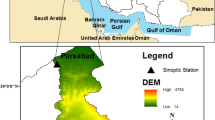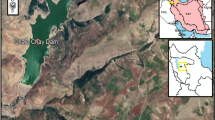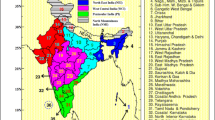Abstract
Evaporation is an important meteorological variable that has a great impact on water resources. In the current research, climatology data, and seasonal coefficient have been used to estimate monthly pan evaporation (Epan) for 2005–2018 study years at four selected stations of the Urmia Lake basin with Dsa and six selected stations of Gavkhouni basin with Bsk climate categories, in Iran. Estimation of monthly Epan was performed using data-driven methods such as artificial neural networks (ANNs), adaptive neuro-fuzzy inference system (ANFIS), and gene expression programming (GEP) as well as wavelet-hybrids (WANN, WANFIS, and WGEP). Based on the evaluation criteria, the WGEP model performance was better than the other models in estimating the monthly Epan. The results indicated that WGEP and ANN are the best and poorest models for all stations without affecting the climate condition of basins. The values of RMSE for WGEP model for stations of Urmia Lake and Gavkhouni basins were varied from 15.839 to 26.727 and 20.651 to 70.318, respectively. Also, the values of RMSE for ANN model for stations of Urmia Lake and Gavkhouni basins were varied from 29.397 to 38.452 and 30.635 to 85.237, respectively. The model’s performance was improved as a result of considering the data noise elimination and applying seasonal coefficient to estimate Epan of various climatic conditions. This study with presenting mathematical equations for estimating monthly Epan has a significant impact on the management and planning of water resources policymakers in the future.















Similar content being viewed by others
Data availability
All of the required data have been presented in our article.
References
Abghari, H., Ahmadi, H., Besharat, S., & Rezaverdinejad, V. (2012). Prediction of daily pan evaporation using wavelet neural networks. Water resources management, 26(12), 3639–3652
Adnan, R. M., Heddam, S., Yaseen, Z. M., Shahid, S., Kisi, O., & Li, B. (2021). Prediction of potential evapotranspiration using temperature-based heuristic approaches. Sustainability, 13(1), 297
Adnan, R. M., Malik, A., Kumar, A., Parmar, K. S., & Kisi, O. (2019). Pan evaporation modeling by three different neurofuzzy intelligent systems using climatic inputs. Arabian Journal of Geoscience, 12, 606–614
Ahmadaali, Kh., Liaghat, A.M., Heydari, N., & Bozorg-Haddad, O. (2013). Application of artificial neural network and adaptive neural-based fuzzy inference system techniques in estimating of virtual water. International Journal of Computer Applications (0975 – 8887), 76 (6)
Araghi, A., Adamowski, J., & Martinez, C. J. (2020). Comparison of wavelet-based hybrid models for the estimation of daily reference evapotranspiration in different climates. Journal of Water and Climate Change, 11(1), 39–53
Ashrafzadeh, A., Ghorbani, M. A., Biazar, S. M., & Yaseen, Z. M. (2019). Evaporation process modelling over northern Iran: application of an integrative data-intelligence model with the krill herd optimization algorithm. Hydrological Sciences Journal, 64(15), 1843–1856
Azamathulla, H. M., Rathnayake, U., & Shatnawi, A. (2018). Gene expression programming and artificial neural network to estimate atmospheric temperature in Tabuk, Saudi Arabia. Applied Water Science, 8(6), 1–7
Burt, C. M., Mutziger, A. J., Allen, R. G., & Howell, T. A. (2005). Evaporation research: Review and interpretation. Journal of Irrigation and Drainage Engineering, 131(1), 37–58
Chai, T., & Draxler, R. R. (2014). Root mean square error (RMSE) or mean absolute error (MAE)?–arguments against avoiding RMSE in the literature. Geoscientific model development, 7(3), 1247–1250
Chia, M. Y., Huang, Y. F., Koo, C. H., & Fung, K. F. (2020). Recent Advances in evapotranspiration estimation using artificial intelligence approaches with a focus on hybridization techniques—a review. Agronomy, 10(1), 101
Danandeh Mehr, A., Kahya, E., & Olyaie, E. (2013). Streamflow prediction using linear genetic programming in comparison with a neuro-wavelet technique. Journal of Hydrology, 505, 240–249
Eslamian, S. S., Gohari, S. A., Biabanaki, M., & Malekian, R. (2008). Estimation of monthly pan evaporation using artificial neural networks and support vector machines. Journal of Applied Science, 8(19), 3497–3502
Ghaemi, A., Rezaie-Balf, M., Adamowski, J., Kisi, O., & Quilty, J. (2019). On the applicability of maximum overlap discrete wavelet transform integrated with MARS and M5 model tree for monthly pan evaporation prediction. Agricultural and Forest Meteorology, 278, 107647
Ghavidel, S. Z. Z., & Montaseri, M. (2014). Application of different data-driven methods for the prediction of total dissolved solids in the Zarinehroud basin. Stochastic Environmental Research and Risk Assessment, 28(8), 2101–2118
Guven, A., & Kisi, O. (2013). Monthly pan evaporation modeling using linear genetic programming. Journal of Hydrology, 503, 178–185
Holland, J.H. (1975). Adaptation in natural and artificial systems: An introductory analysis with applications to biology, control and artificial intelligence. MIT Press, 1992. First Published by University of Michigan Press, USA
Huo, Z., Feng, Sh., Kang, Sh., Huang, G., Wanga, F., & Guo, P. (2012). Integrated neural networks for monthly river flow estimation in arid inland basin of Northwest China. Journal of Hydrology, 420–421, 159–170
Hyndman, R. J., & Koehler, A. B. (2006). Another look at measures of forecast accuracy. International journal of Forecasting, 22(4), 679–688
Jang, J.-S.R. (1993). ANFIS: adaptive network based fuzzy inference system. IEEE Transactions on Systems, Man and Cybernetics., 23(3), 665–683
Jing, W., Yaseen, Z. M., Shahid, S., Saggi, M. K., Tao, H., Kisi, O., & Chau, K. W. (2019). Implementation of evolutionary computing models for reference evapotranspiration modeling: short review, assessment and possible future research directions. Engineering Applications of Computational Fluid Mechanics, 13(1), 811–823
Keshtegar, B., Piri, J., & Kisi, O. (2016). A nonlinear mathematical modeling of daily pan evaporation based on conjugate gradient method. Computers and Electronics in Agriculture, 127, 120–130
Khaniya, B., Priyantha, H. G., Baduge, N., Azamathulla, H. M., & Rathnayake, U. (2020). Impact of climate variability on hydropower generation: a case study from Sri Lanka. ISH Journal of Hydraulic Engineering, 26(3), 301–309
Khatibi, R., Ghorbani, M. A., Naghshara, S., Aydin, H., & Karimi, V. (2020). Introducing a framework for ‘inclusive multiple modelling’ with critical views on modelling practices-Applications to modelling water levels of Caspian Sea and Lakes Urmia and Van. Journal of Hydrology, 124923
Kisi, Ö. (2006). Daily pan evaporation modelling using a neuro-fuzzy computing technique. Journal of Hydrology, 329(3–4), 636–646
Kisi, O., & Aliza mir, M. . (2018). Modelling reference evapotranspiration using a new wavelet conjunction heuristic method: Wavelet extreme learning machine vs wavelet neural networks. Agricultural and Forest Meteorology, 263, 41–48
Kisi, O., & Haddam, S. (2019). Evaporation modelling by heuristic regression approaches using only temperature data. Hydrological Sciences Journal, 64(6), 653–672
Kisi, O., Shiri, J., & Tomball, M. (2013). Modeling rainfall-runoff process using soft computing techniques. Computers and Geosciences, 51, 108–117
Kucuk, M., & Agiralioglu, N. (2006). Wavelet regression techniques for stream flow predictions. Journal of Applied. Statistics., 33(9), 943–960
Majidi, M., Alizadeh, A., Farid, A., & Vazifedoust, M. (2015). Estimating evaporation from lakes and reservoirs under limited data condition in a semi-arid region. Water Resources Management, 29(10), 3711–3733
Malik, A., & Kumar, A. (2015). Pan evaporation simulation based on daily meteorological data using soft computing techniques and multiple linear regression. Water Resources Management, 29(6), 1859–1872
Malik, A., Kumar, A., Kim, S., Kashani, M. H., Karimi, V., Sharafati, A., & Chau, K. W. (2020). Modeling monthly pan evaporation process over the Indian central Himalayas: application of multiple learning artificial intelligence model. Engineering Applications of Computational Fluid Mechanics, 14(1), 323–338
Malik, A., Kumar, A., & Kisi, O. (2017). Monthly pan-evaporation estimation in Indian central Himalayas using different heuristic approaches and climate-based models. Computers and Electronics in Agriculture, 143, 302–313
Mamdani, E. H., & Assilian, S. (1975). An experiment in linguistic synthesis with a fuzzy logic controller. International Journal of Man-Machine Studies, 7, 1–13
McColl, K. A. (2020). Practical and theoretical benefits of an alternative to the Penman‐Monteith evapotranspiration equation. Water Resources Research, 56(6), e2020WR027106
Moghaddamnia, A., Gousheh, M. G., Piri, J., Amin, S., & Han, D. (2009). Evaporation estimation using artificial neural networks and adaptive neuro-fuzzy inference system techniques. Advances in Water Resources, 32(1), 88–97
Montaseri, M., Ghavidel, S. Z. Z., & Sanikhani, H. (2018). Water quality variations in different climates of Iran: toward modeling total dissolved solid using soft computing techniques. Stochastic Environmental Research and Risk Assessment, 32(8), 2253–2273
Nourani, V., Alami, M. T., & Aminfar, M. H. (2009). A combined neural-wavelet model for prediction of Ligvanchai watershed precipitation. Engineering Applications of Artificial Intelligence, 22(3), 466–472
Pammar, L., & Deka, P. C. (2017). Daily pan evaporation modeling in climatically contrasting zones with hybridization of wavelet transform and support vector machines. Paddy and Water Environment, 15(4), 711–722
Perera, A. N. U. S. H. K. A., Azamathulla, H., & Rathnayake, U. P. A. K. A. (2020a). Comparison of different artificial neural network (ANN) training algorithms to predict atmospheric temperature in Tabuk, Saudi Arabia. MAUSAM: Quarterly Journal of Meteorology, Hydrology & Geophysics, 71(2), 551–560
Perera, A., Mudannayake, S. D., Azamathulla, H. M., & Rathnayake, U. (2020b). Recent climatic trends in Trinidad and Tobago, West Indies. Asia-Pacific Journal of Science and Technology, 25(02)
Popoola, A.O. (2007). Fuzzy-wavelet method for time series analysis. University of Surrey. Department of Computing School of Electronics and Physical Sciences University of Surrey Guildford, Surrey GU2 7XH, UK
Qasem, S. N., Samadianfard, S., Kheshtgar, S., Jarhan, S., Kisi, O., Shamshirband, S., & Chau, K. W. (2019). Modeling monthly pan evaporation using wavelet support vector regression and wavelet artificial neural networks in arid and humid climates. Engineering Applications of Computational Fluid Mechanics, 13(1), 177–187
Qutbudin, I., Shiru, M. S., Sharafati, A., Ahmed, K., Al-Ansari, N., Yaseen, Z. M., & Wang, X. (2019). Seasonal drought pattern changes due to climate variability: Case study in Afghanistan. Water, 11(5), 1096
Or, D., & Lehmann, P. (2019). Surface evaporative capacitance: How soil type and rainfall characteristics affect global-scale surface evaporation. Water Resources Research, 55(1), 519–539
Ozger, M. (2010). Significant wave height forecasting using wavelet fuzzy logic approach. Ocean Engineering., 37, 1443–1451
Partal, T., & Kisi, O. (2007). Wavelet and neuro-fuzzy conjunction model for precipitation forecasting. Journal of Hydrology, 342, 199–212
Rezaie-Balf, M., Kisi, O., & Chua, L. H. (2019). Application of ensemble empirical mode decomposition based on machine learning methodologies in forecasting monthly pan evaporation. Hydrology Research, 50(2), 498–516
Sanikhani, H., Kisi, O., Kiafar, H., & Ghavidel, S. Z. Z. (2015). Comparison of different data-driven approaches for modeling lake level fluctuations: the case of Manyas and Tuz Lakes (Turkey). Water Resources Management, 29(5), 1557–1574
Sanikhani, H., Kisi, O., Nikpour, M. R., & Dinpashoh, Y. (2012). Estimation of daily pan evaporation using two different adaptive neuro-fuzzy computing techniques. Water Resources Management, 26(15), 4347–4365
Sebbar, A., Heddam, S., & Djemili, L. (2019). Predicting daily pan evaporation (E pan) from dam reservoirs in the Mediterranean Regions of Algeria: OPELM vs OSELM. Environmental Processes, 6(1), 309–319
Seo, Y., Kim, S., Kisi, O., & Singh, V. P. (2015). Daily water level forecasting using wavelet decomposition and artificial intelligence techniques. Journal of Hydrology, 520, 224–243
Shiri, J. (2019). Evaluation of a neuro-fuzzy technique in estimating pan evaporation values in low-altitude locations. Meteorological Applications, 26(2), 204–212
Shirsath, P. B., & Singh, A. K. (2010). A comparative study of daily pan evaporation estimation using ANN, regression and climate based models. Water Resources Management, 24(8), 1571–1581
Takagi, T., & Sugeno, M. (1985). Fuzzy identification of systems and its applications to modeling and control, IEEE Transactions on Systems, Man and Cybernetics. SMC-15 (1), 116–132
Tan, Q. F., Lei, X. H., Wang, X., Wang, H., Wen, X., Ji, Y., & Kang, A. Q. (2018). An adaptive middle and long-term runoff forecast model using EEMD-ANN hybrid approach. Journal of Hydrology, 567, 767–780
Tao, H., Diop, L., Bodian, A., Djaman, K., Ndiaye, P. M., & Yaseen, Z. M. (2018). Reference evapotranspiration prediction using hybridized fuzzy model with firefly algorithm: Regional case study in Burkina Faso. Agricultural water management, 208, 140–151
Tezel, G., & Buyukyildiz, M. (2016). Monthly evaporation forecasting using artificial neural networks and support vector machines. Theoretical and applied climatology, 124(1–2), 69–80
Trajkovic, S., & Kolakovic, S. (2010). Comparison of simplified pan-based equations for estimating reference evapotranspiration. Journal of Irrigation and Drainage Engineering, 136(2), 137–140
Wang, L., Kisi, O., Hu, B., Bilal, M., Zounemat-Kermani, M., & Li, H. (2017). Evaporation modelling using different machine learning techniques. International Journal of Climatology, 37, 1076–1092
Willmott, C. J., & Matsuura, K. (2005). Advantages of the mean absolute error (MAE) over the root mean square error (RMSE) in assessing average model performance. Climate research, 30(1), 79–82
Yaseen, Z. M., Al-Juboori, A. M., Beyaztas, U., Al-Ansari, N., Chau, K. W., Qi, C., & Shahid, S. (2020). Prediction of evaporation in arid and semi-arid regions: a comparative study using different machine learning models. Engineering applications of computational fluid mechanics, 14(1), 70–89
Yaseen, Z. M., El-Shafie, A., Jaafar, O., Afan, H. A., & Sayl, K. N. (2015). Artificial intelligence-based models for stream-flow forecasting: 2000–2015. Journal of Hydrology, 530, 829–844
ZamanZad-Ghavidel, S., Bozorg-Haddad, O., & Goharian, E. (2020). Sustainability assessment of water resource systems using a novel hydro-socio-economic index (HSEI). (pp. 1–48). Environment.
Zareie, S., & Fakherifard, A. (2014). Assessment of temporal relationship between meteorological and hydrological droughts by GP and ANFIS models in Sofi-Chi basin. Water Resources Engineering Journal, 7(21), 37–50 (In Persian).
Zounemat-Kermani, M., Kisi, O., Piri, J., & Mahdavi-Meymand, A. (2019). Assessment of Artificial Intelligence-Based Models and Metaheuristic Algorithms in Modeling Evaporation. Journal of Hydrologic Engineering, 24(10), 04019033
Funding
The Sari Agricultural Science and Natural Resources University (SANRU) financed this research (Grant No. 02–1399-15).
Author information
Authors and Affiliations
Corresponding author
Ethics declarations
Conflict of interest
The authors declare no competing interests.
Additional information
Publisher's Note
Springer Nature remains neutral with regard to jurisdictional claims in published maps and institutional affiliations.
Appendix
Appendix
Rights and permissions
About this article
Cite this article
Emadi, A., Zamanzad-Ghavidel, S., Fazeli, S. et al. Multivariate modeling of pan evaporation in monthly temporal resolution using a hybrid evolutionary data-driven method (case study: Urmia Lake and Gavkhouni basins). Environ Monit Assess 193, 355 (2021). https://doi.org/10.1007/s10661-021-09060-8
Received:
Accepted:
Published:
DOI: https://doi.org/10.1007/s10661-021-09060-8








